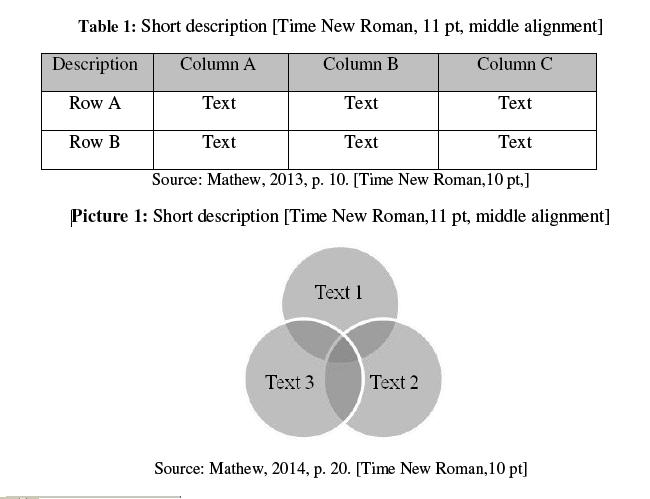The six sessions for paper presentation are as follows: Macro Economics, International Finance, International Trade, Business Administration, Environment Economics, Labor Economics.
1. STRUCTURE OF PAPER:
NAME OF PAPER [Time New Roman, 14 pt, bold type, centered, all in uppercase]
Author’s full name (Time New Roman, 13 pt, bold type, centered)
Email: ........(insert your email here)..........
Title is no more than 20 words and identifies the main issue of the paper which is accurate, unambiguous, specific, and complete and does not contain abbreviations (unless they are well known by the target audience, such as WWW or CPU).
2. ABSTRACT [Time New Roman 12 pt, bold type, left alignment]:
Provide a 150–250 words abstract in English [Time New Roman, 11 pt, justified alignment, no line spacing]. Abstract summarizes the scope and specific theme analysed in the paper, primarily its main results, conclusions and findings.
Keywords: indicate 3–5 keywords [Time New Roman, 11 pt, italic type, left side alignment]
Keywords must capture the essence of full paper. Words must be listed in decreasing order of importance from left to right. These keywords will be used for an electronic index of your paper.
The general structure of a paper compromise five major sections: Introduction, Literature review, Data and methodology, Result and discussion, Conclusion and implications.

3. INTRODUCTION:
The introduction serves the purpose of leading the reader from a general subject area to a particular fieldof research. Three phases of an introduction are required:
1. Reasons to complete research, bring out the importance of the subject
2. Identification of the main research issue
3. Occupation of the niche:
a) sketch the intent of the own work and/or
b) outline important characteristics of the own work
c) outline important results
d) give a brief outlook on the structure of the paper
4. LITERATURE REVIEW:
The Literature review of a paper answers two questions, namely how the research questions were addressed (materials, methods) and what was found (results):
- Overview of the paper and related theories
- The review of related literature
5. DATA AND METHODOLOGY:
Theoretical framework and methodology are using in your paper (the researcher can pick qualitative research method or quantitative research method (or both)).The methods section of your research paper should describe in detail what methodology and special materials, theory papers describe principles concepts and data used for study.
6. RESULT AND DISCUSSION:
- Presentation of background information as well as recapitulation of the research aims of the present study.
- Brief summary of the results focusing on discussing and not recapitulating the results.
- Comparison of results with previously published studies.
- Conclusions or hypotheses drawn from the results, with summary of evidence for each conclusion.
- Proposed follow up research questions.
7. CONCLUSION AND IMPLICATIONS:
With the purpose of research paper: the paper has to provide conclusion and giving some policy implications for company manager and/or policy makers from the papers.
8. FULL PAPER FORMAT:
8.1. FIRST LEVEL HEADING [Time New Roman,12 pt, bold type, left alignment, all in uppercase]
Text must be written in English. The scope of the whole text is limited from 8 - 15 pages, excluding the first page. All text must be written in Time New Roman, 11 pt, justified alignment, with no bold or underlined type. If you wish to emphasize certain text, use italic type. Spacing between lines must be 1.
No page should exceed 45 lines of writing1. Do not include page numbers in your paper. These will be added when the GPAC proceeding is produced.
8.2. Second level heading [Time New Roman,12 pt, bold type, left alignment]
Third level heading [Time New Roman, 11pt, italic type, left alignment]
Structure your text up to three levels deep, however third level must not be numbered.
Tables and figures must be placed within the text of the paper. Generally, graphics should be in Time New Roman 11 pt with table column headings underscored (as seen below). Graphics should be clearly rendered in order to form attractive, readable black-and-white copies. All tables and figures must be included in the paper (no appendices are allowed).
9. REFERENCE LIST [Time New Roman, 13 pt, bold type, centered, all in uppercase]
GPAC uses Havard style for citation and referencing. There are two main types: in-text reference and reference list. Reference list is put in the end of paper, each citation must be correlative in the reference list.
Examples from a reference list in the Harvard Style:
Hamada, T. (1999). “Principles of Information Management”, Journal of Information and Management, Vol.7, No.1, pp.12-34.
Yamada, T. (2000). An Introduction to Information Management, IM Publishers
In-text reference:
- DIRECT QUOTES: When using a direct quote from the text, or paraphrasing a specific section of the text, you must include page numbers (where available) in your in text citation.
- CITING AN ENTIRE WEBSITE: When citing an entire website, it is sufficient to give the address of the site in text only (URL in brackets).
Entire websites are not included in the Reference List.
_________________
For more information, please contact:
Ms.Nguyen Thi Linh Chi
Email: gpacvietnam2014@gmail.com or nguyenlinhchi2410@gmail.com
Tel: (+84) 169 6705 921 (Ms. Chi)